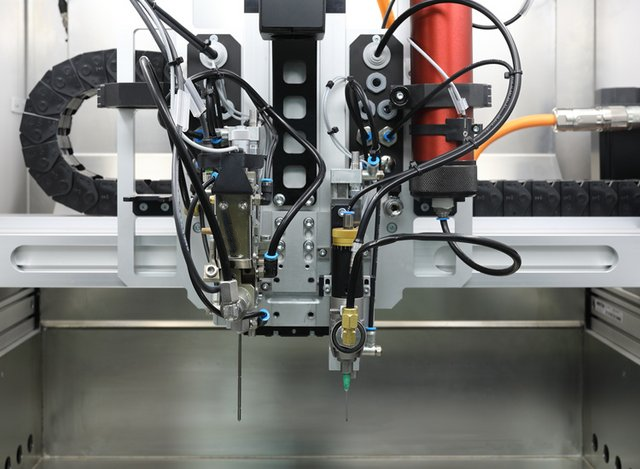Exploration of dispensing defect detection technology based on machine vision
Release time:2024-02-01Publisher:Jeenoce
With the rapid development of industrial automation control technology and computer technology, industrial automation has penetrated into the production of various industries. Automatic dispensing machines have been widely used in industrial production, playing an important role in product connection, coating, and sealing from the microcircuit industry, electronic product industry, LED industry to general industry. The application of automatic dispensing machines not only greatly improves the quality of products, but also improves production efficiency, enabling complex dispensing processes. On this basis, the quality issue of dispensing is of greater concern. In actual production, due to various factors such as the dispensing process level of the automatic dispensing machine, the temperature of the glue, etc., the produced glue may produce defects such as bubbles, broken glue strips, and the width of the glue strips being too thick or too thin. Therefore, in various situations where the connection effect needs to be achieved through dispensing, it is extremely important to strictly control the quality of dispensing. Relying on manpower to detect dispensing defects is obviously unreasonable. Due to its large workload, low efficiency, and low detection accuracy, it can no longer meet the actual production needs. In order to solve the above problems, machine vision based dispensing defect detection technology has been widely applied, which has the advantages of low cost, high accuracy, and fast speed.

1、 Current status of machine vision based detection technology
Machine vision is based on ordinary computer vision research and involves practical technologies such as light source illumination technology and high-speed image acquisition. In industry, building a complete industrial vision application system using machine vision requires the integration of various technologies, including mechanical engineering, sensors, optical imaging, motion control, image processing, and more. Figure 1-1 shows the overall framework of a machine vision system in actual industry, which mainly includes the tested target, light source, optical imaging system, image capture system, image acquisition and digitization, intelligent image processing module, and motion control module.
With the advancement of technology, the development speed of machine vision is also getting faster and faster. Some foreign research and development institutions have developed many machine vision system software based on image processing, such as MatroxImaging Library (MIL), Halcon, Matlab, and open-source library OpenCV. Due to their powerful image processing capabilities, these software have been widely used in practical industrial production. At present, there are two types of algorithms in machine vision, namely digital image processing algorithms and deep learning algorithms based on convolutional neural networks.
(1) The method based on digital image processing mainly obtains the area, centroid, and customized complexity formula of the adhesive layer through image processing and other operations to determine the quality of the adhesive layer. The traditional methods based on digital image processing have the advantages of simple operation and fewer parameters, but they also have disadvantages such as being easily affected by objective factors such as lighting, poor adhesive layer segmentation effect, poor defect classification, and poor universality.
(2) With the advent of the big data era, the easy access to various information resources has made the application of deep learning increasingly widespread. Especially in convolutional neural networks, after deep convolution and pooling of images, the hidden layer can exhibit more generalized and abstract features than manually obtained, thus achieving good results in recognition and classification. The emergence of deep learning has brought greater feasibility to the recognition of dispensing defects. However, deep learning requires sufficient training data and powerful computing power, which restricts its implementation and application in many fields, and directly affects the detection efficiency of point defect glue.
2、 Optical detection scheme for dispensing detection system
In the process of dispensing defect detection, the continuous and stable acquisition of image information is also a crucial step. The quality of the image has a great impact on the difficulty of algorithm design. Therefore, in the design process of dispensing defect detection system, it is necessary to select the hardware for optical detection. As shown in Figure 2-1, considering that the adhesive strip is transparent and has reflective effects, it is required that the light source has a relatively uniform illumination degree at various angles, while coaxial light has the characteristics of high-density arrangement, clear imaging, and uniform brightness. In addition, while requiring uniform illumination brightness, due to the presence of bubbles in some rubber strips and the distance between the coaxial light source and the rubber strip, the collected images cannot observe the characteristics of the bubbles. Therefore, it is considered to use a strip light source to illuminate the upper part of the rubber strip, making the characteristics of the bubbles visible. Due to the advantages of large illumination area and good uniformity of illumination, the vertical illumination method is chosen for coaxial light sources, while the strip light source is mainly used to enhance the illumination of the adhesive strip. At the same time, in order to not block the coaxial light source, side illumination is chosen.

